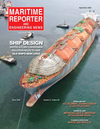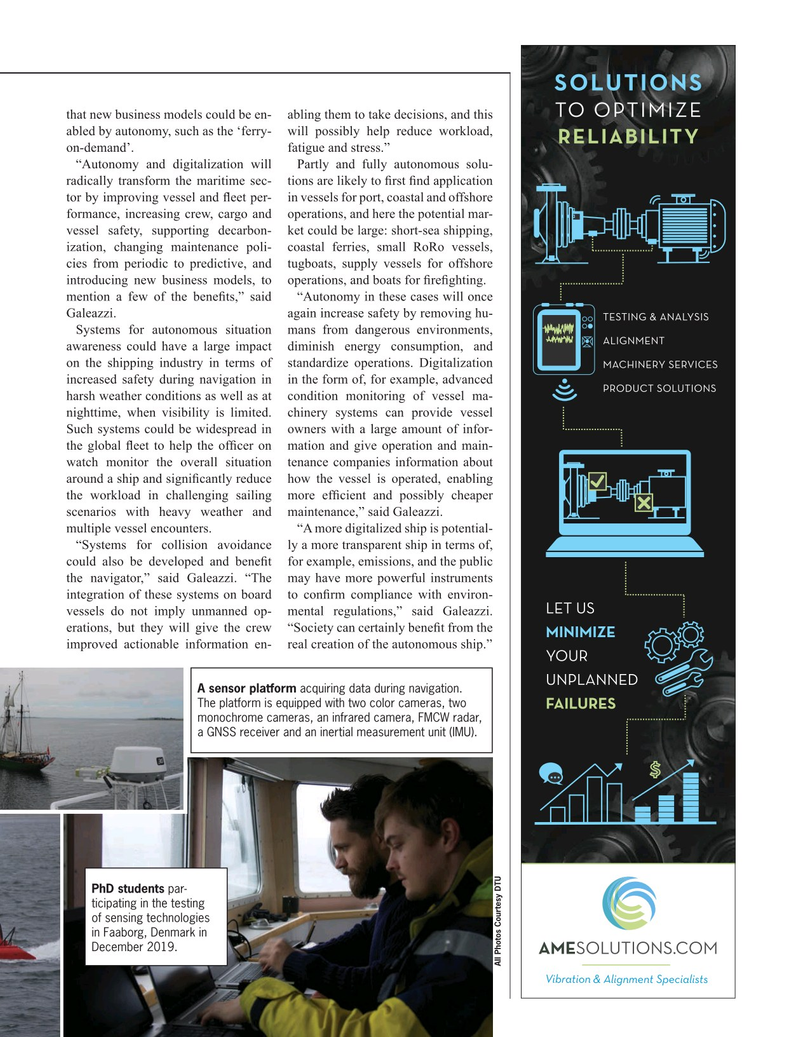
Page 21: of Maritime Reporter Magazine (September 2020)
Marine Design Annual
Read this page in Pdf, Flash or Html5 edition of September 2020 Maritime Reporter Magazine
SOLUTIONS
TO OPTIMIZE that new business models could be en- abling them to take decisions, and this abled by autonomy, such as the ‘ferry- will possibly help reduce workload,
RELIABILITY on-demand’. fatigue and stress.” “Autonomy and digitalization will Partly and fully autonomous solu- radically transform the maritime sec- tions are likely to ? rst ? nd application tor by improving vessel and ? eet per- in vessels for port, coastal and offshore formance, increasing crew, cargo and operations, and here the potential mar- vessel safety, supporting decarbon- ket could be large: short-sea shipping, ization, changing maintenance poli- coastal ferries, small RoRo vessels, cies from periodic to predictive, and tugboats, supply vessels for offshore introducing new business models, to operations, and boats for ? re? ghting.
mention a few of the bene? ts,” said “Autonomy in these cases will once
Galeazzi. again increase safety by removing hu-
TESTING & ANALYSIS
Systems for autonomous situation mans from dangerous environments,
ALIGNMENT awareness could have a large impact diminish energy consumption, and on the shipping industry in terms of standardize operations. Digitalization
MACHINERY SERVICES increased safety during navigation in in the form of, for example, advanced
PRODUCT SOLUTIONS harsh weather conditions as well as at condition monitoring of vessel ma- nighttime, when visibility is limited. chinery systems can provide vessel
Such systems could be widespread in owners with a large amount of infor- the global ? eet to help the of? cer on mation and give operation and main- watch monitor the overall situation tenance companies information about around a ship and signi? cantly reduce how the vessel is operated, enabling the workload in challenging sailing more ef? cient and possibly cheaper scenarios with heavy weather and maintenance,” said Galeazzi.
multiple vessel encounters. “A more digitalized ship is potential- “Systems for collision avoidance ly a more transparent ship in terms of, could also be developed and bene? t for example, emissions, and the public the navigator,” said Galeazzi. “The may have more powerful instruments integration of these systems on board to con? rm compliance with environ-
LET US vessels do not imply unmanned op- mental regulations,” said Galeazzi. erations, but they will give the crew “Society can certainly bene? t from the
MINIMIZE improved actionable information en- real creation of the autonomous ship.”
YOUR
UNPLANNED
A sensor platform acquiring data during navigation.
The platform is equipped with two color cameras, two
FAILURES monochrome cameras, an infrared camera, FMCW radar, a GNSS receiver and an inertial measurement unit (IMU).
PhD students par- ticipating in the testing of sensing technologies in Faaborg, Denmark in
December 2019.
All Photos Courtesy DTU
MR #9 (18-33).indd 21 9/9/2020 8:03:50 AM

 20
20

 22
22
